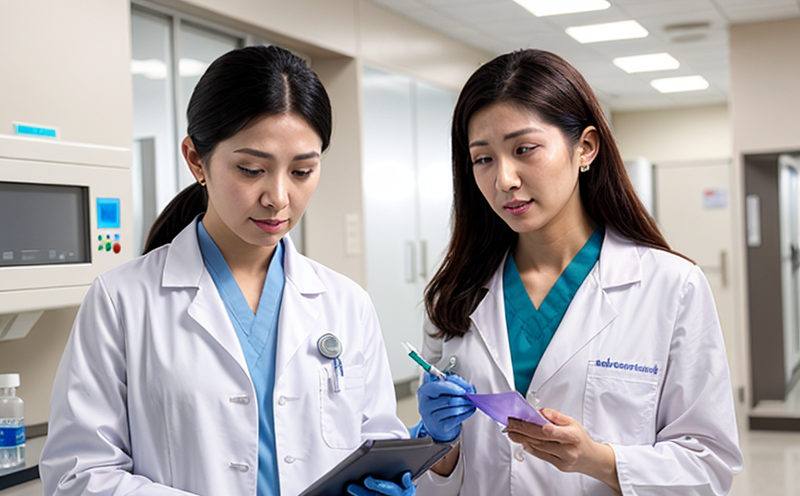Extractables and Leachables Testing for Biopharmaceutical Containers
The testing of extractables and leachables from containers used in the biopharmaceutical industry is a critical component of ensuring drug product safety. This service involves identifying potential contaminants that may be introduced into the final drug product during processing, packaging, storage, or shipping.
Biopharmaceuticals are complex molecules and require specialized testing to ensure they remain stable throughout their lifecycle. Extractables are substances that can be extracted from a container using specific solvents under defined conditions, while leachables are those that enter the drug product during use. Both can pose risks if not properly managed.
The process begins with selecting appropriate containers for biopharmaceuticals based on their chemical composition and design. Common materials include polyethylene terephthalate (PET), high-density polyethylene (HDPE), glass, and various types of plastic. Each material has unique properties that influence its potential to release extractables or leachables.
Testing is conducted using validated methods that simulate real-world conditions as closely as possible. This includes selecting appropriate solvents, temperatures, times, and concentrations based on the container’s intended use. The testing process typically involves several steps:
- Solvent selection
- Solvent contact time
- Temperature control
- Extraction procedure
- Sample preparation
- Analytical techniques
The extracted compounds are then analyzed using high-performance liquid chromatography (HPLC), inductively coupled plasma mass spectrometry (ICP-MS), and other advanced analytical tools. The results provide detailed information about the chemical composition of both extractables and leachables.
Compliance with international standards such as ISO 10993, ASTM E2348, and EN 16573 ensures that the testing meets industry best practices. These standards help ensure consistent quality across different laboratories and countries, which is crucial for global pharmaceutical supply chains.
Understanding the risks associated with extractables and leachables helps manufacturers design safer products and packaging solutions. By identifying potential issues early in the development process, companies can implement corrective actions to minimize these risks.
| Container Material | Potential Extractables/Leachables |
|---|---|
| PET | Ethanediol, p-xylene |
| HDPE | Dioxane, 1,2-dichloroethane |
| Glass | Silica dioxide, borosilicate compounds |
| Plastic (PP) | Bisphenol A (BPA), polycarbonate derivatives |
The comprehensive nature of extractables and leachables testing ensures that all relevant aspects are considered, from raw material selection to final product safety. This service plays a vital role in maintaining the integrity and efficacy of biopharmaceuticals throughout their lifecycle.
Frequently Asked Questions
International Acceptance and Recognition
The importance of extractables and leachables testing is widely recognized by international bodies such as the World Health Organization (WHO) and the U.S. Food and Drug Administration (FDA). Compliance with these standards ensures that biopharmaceutical products meet global quality expectations.
International acceptance extends beyond regulatory compliance to include industry best practices. Laboratories adhering to these standards are often preferred by pharmaceutical companies due to their reliability and consistency in results. This contributes significantly to the reputation of a laboratory within the sector.
| Regulatory Body | Standard |
|---|---|
| WHO | PQ1 Extractables and Leachables Study Design and Implementation Guidelines |
| FDA | CIPAS 358 Extractables and Leachables Guidelines |
| European Medicines Agency (EMA) | Guideline on Quality of Excipients |
The widespread adoption of extractables and leachables testing underscores its significance in maintaining high standards of safety and quality for biopharmaceuticals.
Competitive Advantage and Market Impact
- Pioneering expertise in cutting-edge analytical techniques
- Comprehensive compliance with international standards
- State-of-the-art laboratory facilities
- Dedicated team of experts
The ability to conduct comprehensive extractables and leachables testing provides a significant competitive advantage. It allows companies to stay ahead in the rapidly evolving biopharmaceutical industry by ensuring product safety and quality.
This service not only enhances brand reputation but also contributes positively to market impact. By maintaining high-quality standards, laboratories like ours help ensure that biopharmaceuticals are safe for patients worldwide.
Use Cases and Application Examples
- Ensuring drug product safety during storage and transportation
- Minimizing contamination risks in clinical trials
- Complying with regulatory requirements for global distribution
Extractables and leachables testing plays a crucial role in several key areas:
| Use Case | Description |
|---|---|
| Storage and Transportation Safety | Identifies potential contaminants that could affect drug stability during prolonged storage periods or transportation. |
| Clinical Trial Compliance | Maintains strict quality control to ensure the integrity of clinical trial samples. |
| Global Distribution Regulations | Achieves compliance with regulatory standards for biopharmaceuticals distributed internationally. |
The diverse applications of this service underscore its importance in safeguarding biopharmaceutical quality and safety.





